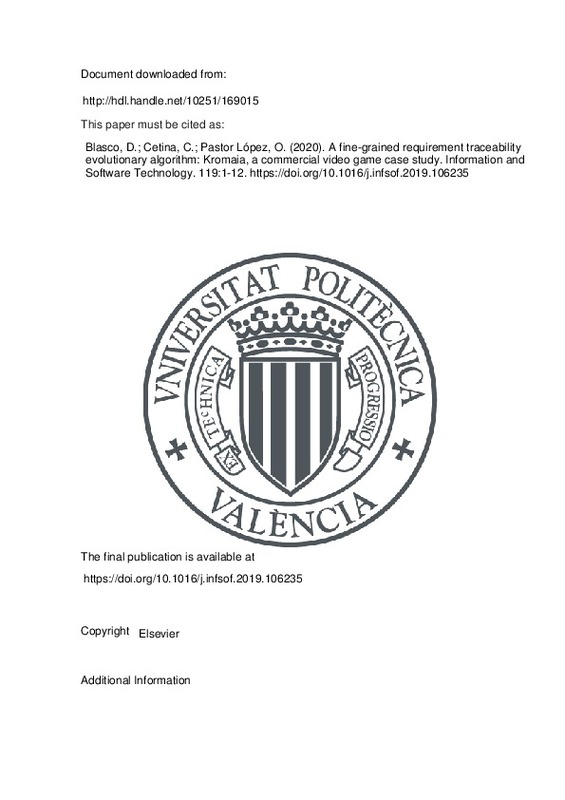Watkins, R., & Neal, M. (1994). Why and how of requirements tracing. IEEE Software, 11(4), 104-106. doi:10.1109/52.300100
Rempel, P., & Mader, P. (2017). Preventing Defects: The Impact of Requirements Traceability Completeness on Software Quality. IEEE Transactions on Software Engineering, 43(8), 777-797. doi:10.1109/tse.2016.2622264
Borg, M., Runeson, P., & Ardö, A. (2013). Recovering from a decade: a systematic mapping of information retrieval approaches to software traceability. Empirical Software Engineering, 19(6), 1565-1616. doi:10.1007/s10664-013-9255-y
[+]
Watkins, R., & Neal, M. (1994). Why and how of requirements tracing. IEEE Software, 11(4), 104-106. doi:10.1109/52.300100
Rempel, P., & Mader, P. (2017). Preventing Defects: The Impact of Requirements Traceability Completeness on Software Quality. IEEE Transactions on Software Engineering, 43(8), 777-797. doi:10.1109/tse.2016.2622264
Borg, M., Runeson, P., & Ardö, A. (2013). Recovering from a decade: a systematic mapping of information retrieval approaches to software traceability. Empirical Software Engineering, 19(6), 1565-1616. doi:10.1007/s10664-013-9255-y
Landauer, T. K., Foltz, P. W., & Laham, D. (1998). An introduction to latent semantic analysis. Discourse Processes, 25(2-3), 259-284. doi:10.1080/01638539809545028
Poshyvanyk, D., Gueheneuc, Y.-G., Marcus, A., Antoniol, G., & Rajlich, V. (2007). Feature Location Using Probabilistic Ranking of Methods Based on Execution Scenarios and Information Retrieval. IEEE Transactions on Software Engineering, 33(6), 420-432. doi:10.1109/tse.2007.1016
Dit, B., Revelle, M., Gethers, M., & Poshyvanyk, D. (2011). Feature location in source code: a taxonomy and survey. Journal of Software: Evolution and Process, 25(1), 53-95. doi:10.1002/smr.567
Arcuri, A., & Fraser, G. (2013). Parameter tuning or default values? An empirical investigation in search-based software engineering. Empirical Software Engineering, 18(3), 594-623. doi:10.1007/s10664-013-9249-9
Stehman, S. V. (1997). Selecting and interpreting measures of thematic classification accuracy. Remote Sensing of Environment, 62(1), 77-89. doi:10.1016/s0034-4257(97)00083-7
Apache opennlp: Toolkit for the processing of natural language text, 2017, (https://opennlp.apache.org/). [Online; accessed 12-November-2017].
P. Abeles, Efficient java matrix library, 2017, (http://ejml.org/). [Online; accessed 9-November-2017].
IGDA, International Game Developers Association, 2018.
Lucia, A. D., Fasano, F., Oliveto, R., & Tortora, G. (2007). Recovering traceability links in software artifact management systems using information retrieval methods. ACM Transactions on Software Engineering and Methodology, 16(4), 13. doi:10.1145/1276933.1276934
De Lucia, A., Oliveto, R., & Tortora, G. (2008). Assessing IR-based traceability recovery tools through controlled experiments. Empirical Software Engineering, 14(1), 57-92. doi:10.1007/s10664-008-9090-8
Zou, X., Settimi, R., & Cleland-Huang, J. (2009). Improving automated requirements trace retrieval: a study of term-based enhancement methods. Empirical Software Engineering, 15(2), 119-146. doi:10.1007/s10664-009-9114-z
Unterkalmsteiner, M., Gorschek, T., Feldt, R., & Lavesson, N. (2015). Large-scale information retrieval in software engineering - an experience report from industrial application. Empirical Software Engineering, 21(6), 2324-2365. doi:10.1007/s10664-015-9410-8
Bavota, G., De Lucia, A., Oliveto, R., & Tortora, G. (2014). Enhancing software artefact traceability recovery processes with link count information. Information and Software Technology, 56(2), 163-182. doi:10.1016/j.infsof.2013.08.004
[-]







![[Cerrado]](/themes/UPV/images/candado.png)


